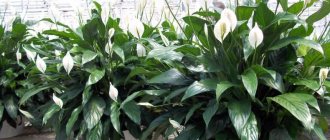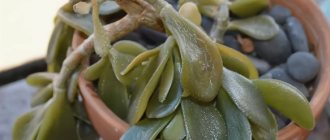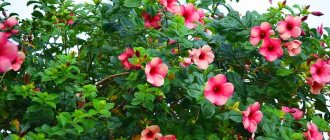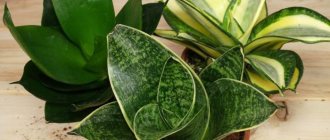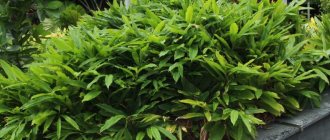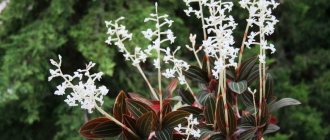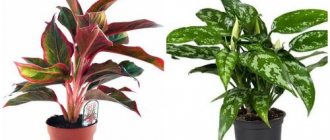Maranta does not need spectacular inflorescences; it is beautiful without them. Its variegated, patterned leaves have delighted gardeners for over 400 years. Marantophiles never tire of being amazed by the touching habit of this delicate flower - folding its leaves in the evening, as if reading a prayer. Seeing this “gesture,” the British called arrowroot a prayer plant and attributed mystical properties to it. South American Indians also have legends associated with arrowroot. No matter what continent the fans of this whimsical plant live on, they are convinced that the whims of arrowroot are worth fulfilling in order to admire the magically colored leaves that are so similar to the feathers of strange birds. Below we will tell you about the features of caring for this unusual plant at home.
Photo gallery
Problems
Dry air causes leaf tips to become brown and dry, leaves may fall off, and plant growth may be stunted. Fertilizing with mineral fertilizers and air humidification will help.
In winter, at low temperatures and abundant watering, the stems become lethargic and may rot. Urgent replanting and removal of rotten roots and stems will help.
With insufficient watering, leaves may curl and become covered with dark spots, and the lower leaves may turn yellow. The soil should always be slightly moist.
With too much light, leaves may curl, lose color, or dry out. Move the plant to a less bright place.
What kind of soil is needed?
Light, nutritious, breathable soil is considered suitable for arrowroot. The choice of ready-made store-bought mixtures is quite wide, but when purchasing, choose only those that were originally intended for arrowroot. This will be indicated on the packaging. Pay attention to the composition, which should contain leaf/turf soil, peat, humus and mineral complexes.
Among the disadvantages of the ready-made mixture, it can be noted that the substrate in its pure form still does not meet the requirements and requires additional additives - most often these are spruce needles, sphagnum and peat. Before planting, it is advisable to check the acidity of the substrate: the pH level should not exceed 6.0.
The soil needed for arrowroot is very easy to prepare yourself. The simplest option is a mixture of soil, peat and sand in proportions 3:2:1. Experienced gardeners advise, if possible, to add either sphagnum moss or crushed charcoal. The soil mixture should be quite loose. Pebbles, expanded clay, shards or coarse sand are suitable for drainage.
Temperature
Maranta does not tolerate both overheating and hypothermia. In summer it is advisable to maintain a temperature of 22–25° C; at higher temperatures, increased humidity is necessary (see below).
From mid-autumn to the end of spring, the optimal temperature is 18–20° C, and it should never fall below 10° C, otherwise the plant will die.
Maranta is quite thermophilic. If kept too cool, the stems and leaves may begin to rot, and if the situation is not changed, the plant will die. Overheating is also dangerous for the plant.
It tolerates sudden temperature changes very poorly and does not tolerate drafts. Therefore, even in the warm season, it is not recommended to take it outside or, as a last resort, choose a place completely protected from wind, sun and drafts.
Reproduction
Can be propagated by cuttings or division. It is best to propagate by cuttings from May to the end of August. To do this, the best way is to cut the tops of new shoots with 2-3 healthy internodes.
Place them in water, and after 4-5 weeks, when the roots reach 3 cm in length, the plants can be planted in a shallow pot. After planting for rooting, provide the arrowroot with a greenhouse effect by covering the pot with film.
Propagation by division is best done in the spring when transplanting the plant into another pot or changing the soil. Sterilize the knife and cut the bush so that each part remains completely viable. To do this, leave part of the roots and a growing point for each division.
Before placing the separated parts in the pot, do not forget to sprinkle crushed coal on the cut roots of each.
In this case, the plant will also need a greenhouse effect, so water the seedlings and cover them with a plastic bag or film.
Diseases
The most common arrowroot diseases:
- The tips of arrowroot leaves dry out
The tops dry out and fall off when the air in the room is as dry as possible.
- Rot has formed on the arrowroot
Rot appears if the plant is watered too much or the plant is in the cold.
- Spots on arrowroot foliage
Specks form if the plant lacks moisture.
- Maranta turns pale
The leaves lose their showiness and dry out when the plant is exposed to direct sunlight.
Fertilizer and feeding
Arrowroot needs mineral and organic fertilizers; it reacts sharply to the slightest excess feeding. Experienced flower growers recommend diluting all fertilizers with 2 times the amount of water specified in the instructions.
Fertilizing is relevant during the period of active growth - from the beginning of spring to the beginning of autumn. Organic and mineral fertilizers must be alternated and the soil must be fertilized once every 2 weeks. Pokon, Bona Forte and Agricola formulations have received many positive reviews.
Ordinary ash has the properties of organic fertilizer. It can be used to flavor the soil either in dry form or in a solution of 1 tablespoon of ash with 1 liter of clean, settled water.
But the mixture must first be kept for 24 hours and only then the substrate must be watered.
Arrowroot: plant energy
Maranta combines within itself the energy of Mars, the Sun and Mercury. Therefore, she has the ability to cleanse the house of negativity and aggression, as well as attract wealth and good luck into it. It is believed that the flower will be useful for families whose members are active and emotional people.
Arrowroot can also help those who have problems sleeping - it promotes relaxation, avoidance of fuss and worries. The flower is also perfect for people who are in search of themselves, who believe that their lives are wasted, and those who have lost hope of finding happiness.
The plant can also have a positive effect on the speed of learning and commercial activity. In addition, a person under its influence finds it easier to get along with others.
Watering
For irrigation you will need clean soft water up to 5 °C above room temperature. In summer, the flower needs increased moisture, and it should be watered at least once every 48 hours. In this case, it is necessary to control the general level of humidity of the substrate so that the roots do not rot.
For additional moisture, initially place the arrowroot on a tray filled with gravel or expanded clay filled with water.
In winter, water the flower no more than 1-2 times a week, depending on the degree of dry air caused by the heating season.
How to organize watering during a long absence?
The lack of necessary moisture leads to rapid drying out of the arrowroot. If you are going on vacation, make sure in advance that the flower has access to a source of moisture. To do this, you can use 3 options:
- Place wet sphagnum moss on the surface of the substrate. This will help retain moisture in the roots.
- Place a layer of expanded clay, pebbles or sand in a drainage pan and fill everything with water. Place the arrowroot on top so that the bottom of the pot does not directly touch the water.
- If possible, place the plant in a florarium.
Arrowroot for home growing: varieties
At home, only six varieties of arrowroot are grown - two-color, three-color, reed, white-veined and its hybrids - Kerkhova and Massangena.
Arrowroot two-color
The plant has oval, short-petioled leaves about 15 cm long with slightly wavy edges. On the front side they are painted in two shades of green - the lighter one is in the center along the midrib and darkens towards the edges. There are also brown spots on the surface. The reverse side of the leaf is covered with hairs and colored pale red. A distinctive feature of the species is that it does not form tubers.
Arrowroot reed
Reed arrowroot is a shrub whose height slightly exceeds 1 m. On hard, erect stems there are large ovoid (up to 25 cm) leaves with slightly pointed tips. Their reverse side is dark green and covered with hairs. The plant has thick tuberous edible roots.
Arrowroot tricolor (fascinator, red veined)
Arrowroot tricolor is one of the most decorative species. Its representatives grow up to 40 cm in height. The oval, velvety leaves of the flower grow on short petioles; they are dark green in the center and lighten towards the edges.
Their surface is decorated with pale green spots along the midrib and dark green feather-like spots along the lateral ones. A distinctive feature of the species is the red color of the veins. The underside of the leaves is crimson or lilac-violet.
Arrowroot white-veined (white-veined)
White-veined arrowroot is a compact plant with large rounded-elliptical leaves decorated with a regular geometric pattern. Their width is about 9 cm, length - up to 15 cm. The surface of the leaf blade is dark green, the pattern on it is pale green, the veins are white. The reverse side can be silver, greenish blue, pale red or burgundy.
Maranta Kerkhova
Arrowroot Kerkhova is a small (up to 25 cm in height) plant with short-petioled oval leaves. The upper bright green side of the leaf blade is decorated with many dark green spots and a white stripe located along the midrib. The bottom of the leaf can be light blue, dark red, or some shade in between.
Maranta Massangena
Arrowroot Massangena has large oval leaves of an unusual color: near the central vein there is a mint spot with a dark brown border, the outer edge is bluish-green with light stripes along the veins.
Diseases
There are no specific diseases unique to the arrowroot family. All problems are caused by simple carelessness of the owner or failure to comply with mandatory care conditions.
Any ailment of the arrowroot will be clearly demonstrated by its appearance. There is a high probability that growth will stop. All this is provoked by three main reasons: root rotting, insect damage and insufficient air humidity.
The fact that rotting has occurred in the root system can be recognized by wilted leaves in wet soil. Most likely, the flower suffers from low temperatures due to abundant watering or poor-quality soil. To eliminate the problem, it is necessary to dry the soil, eliminate the affected areas and establish a proper watering regime. In some cases, it makes sense to transplant the arrowroot into a new sterilized substrate.
A little history about arrowroot
Arrowroot is a perennial herbaceous plant native to the tropical rainforests of Central and South America. The flower began to be cultivated more than 7,000 years ago. This is confirmed by excavations in the Caribbean, during which archaeologists discovered starch made from its rhizomes.
In the 16th century, William Houston, a plantation owner in South America, learned from local tribes about the medicinal properties of a flower that the natives called “arrow root.” The nickname was not accidental - the plant was used to treat the wounded with arrows with poisoned tips.
Later, Houston brought its seeds to Europe, where he began to grow them in his pharmacy garden. This is how the Venetian physician Barthalomeo Maranta learned about the flower, whose surname formed the basis of the official name of the plant.
However, besides him, arrowroot has other names - “princess frog”, “pagan” and “10 commandments”. People began to call the flower “the princess frog” for its unusual color - supposedly it resembles the skin of the enchanted Vasilisa the Beautiful.
The nickname “bogomolets” (“prayer plant”) appeared due to the fact that in the evening, when the lighting becomes insufficient, the leaves of the arrowroot take a vertical position and close together. From the outside it looks like a person praying. In the morning they return to their original state.
In England, it was customary to keep arrowroot in every home - the 10 spots that appear on its leaves were associated with the 10 commandments. Hence the origin of the last name.
Pests
There are two dangerous pests for arrowroot - scale insects and spider mites.
Shchitovka
A very small insect, up to 5 mm in size, with a waxy shield that completely covers its body. Appears on the flower if care is not accompanied by regular air humidification; it feeds on arrowroot juice.
Affected leaves can be easily identified by raised bumps or plaques of green, brown or yellow color on the outside or inside. If the arrowroot is infected quite recently, and the scale insect is not yet visible to the naked eye, it can be detected by the sticky secretion on the flower that it leaves.
Insect control is carried out using a soap solution and insecticides. Using a cotton swab dipped in soapy water, thoroughly wipe the leaves to remove adult insects.
The same can be done using Karbofos solution. After this, spray the flower with one of the following products: Aktara, Bankol, Mospilan, Actellik or their analogues. At the same time, do not forget to treat the surface on which the flower stands.
If the arrowroot is on the windowsill, even the nearest window glass must be treated.
Spider mite
Microscopic arthropod insect. Infected leaves are distinguished by small yellow dots, which subsequently merge into one large spot. The mite appears due to dry air; in some cases, the cause is called, on the contrary, excessive humidity. At the same time, the tick can be brought into the apartment already on the leaves of an infected arrowroot, in a purchased substrate, or in the soil from the street.
Get rid of the pest by wiping the leaves and stem with soapy water and acaricides. Among the most effective are Vertimek, Akarin, Neoron, Fitoverm and Actellik.
To prevent scale insects and spider mites, do not forget to systematically moisten the room where the flower is located. Do not place any purchased cut bouquets next to arrowroot. And keep all new purchased plants in a 3-week quarantine in another room.
Description
Few indoor flowers can boast such colorful leaves, which represent the main decorative value of the crop. Their color varies from almost white to dark green.
The leaf pattern is represented by contrasting spots, stripes and characteristic veins. The plant is distinguished by a very interesting and rare feature, inherent in some representatives of the Maranthaceae family (calathea, stromanta, ctenantha).
It lies in the reaction of leaves to light. In low light or at nightfall, the shoots rise almost vertically, and the arrowroot leaves curl slightly, but when the sun appears or the phytolamp is turned on, they fall again, unfurling foliage with a bright pattern.
Thanks to this effect, arrowroot received a second name - “prayer plant”.
In indoor floriculture, a flower can serve as a kind of living indicator of the level of light and humidity, “predicting” bad weather and rain, which has led to the spread of various superstitions and signs associated with arrowroot.
The flowering of arrowroot also deserves attention. Snow-white, beige or pale lilac, small flowers are collected in a spikelet inflorescence, which is located at the top of a thin peduncle.
Errors when leaving
Any deviation from the rules for maintaining arrowroot is immediately reflected in the condition of its leaves. They curl, dry out or turn yellow. The flower suffers from certain mistakes of novice gardeners, and the most common of them are:
- unacceptably dry air;
- insufficient soil moisture;
- too heavy, unsuitable soil;
- the flower is exposed to the negative influence of direct sunlight;
- the flower is in a draft;
- the air temperature has dropped below the permissible 17 °C;
- arrowroot is affected by insects in a neglected form.
Maranta will enliven and decorate any interior. If you don’t already have such a flower, you can purchase or order it from flower shops. The cost depends on the type of plant, region and place of sale, and ranges from 150 to 900 rubles.
Signs of improper home care for arrowroot
Arrowroot always notifies the owner about the presence of errors in care with the help of leaves. It is enough to study the plant’s signals to quickly adjust the conditions.
| Leaf problem | Cause |
| Turn yellow | Water scarcity |
| Covered with yellow spots | Sunburn, or low temperature, or exposure to a draft. |
| Dry from the edges | Lack of nutrients or moisture, use of poor quality water. |
| Curl up | Low temperature, lack of water. |
| Losing color | Excess light |
| Pull out and fold together | Lack of light |
